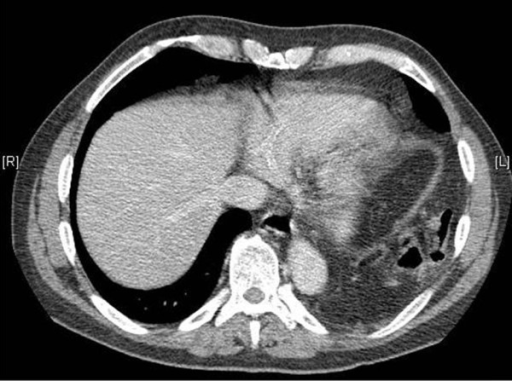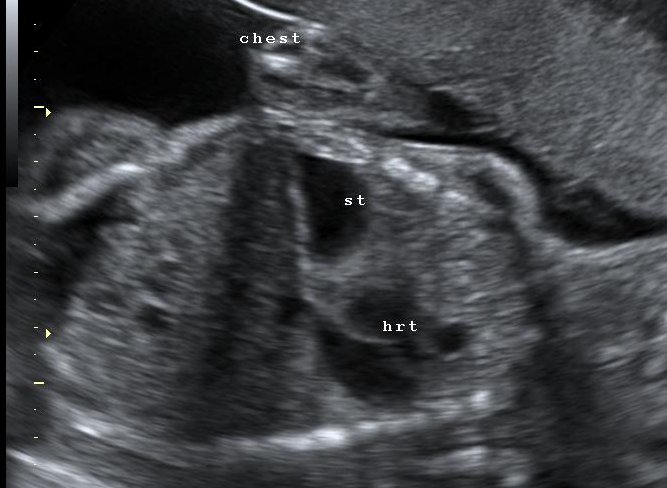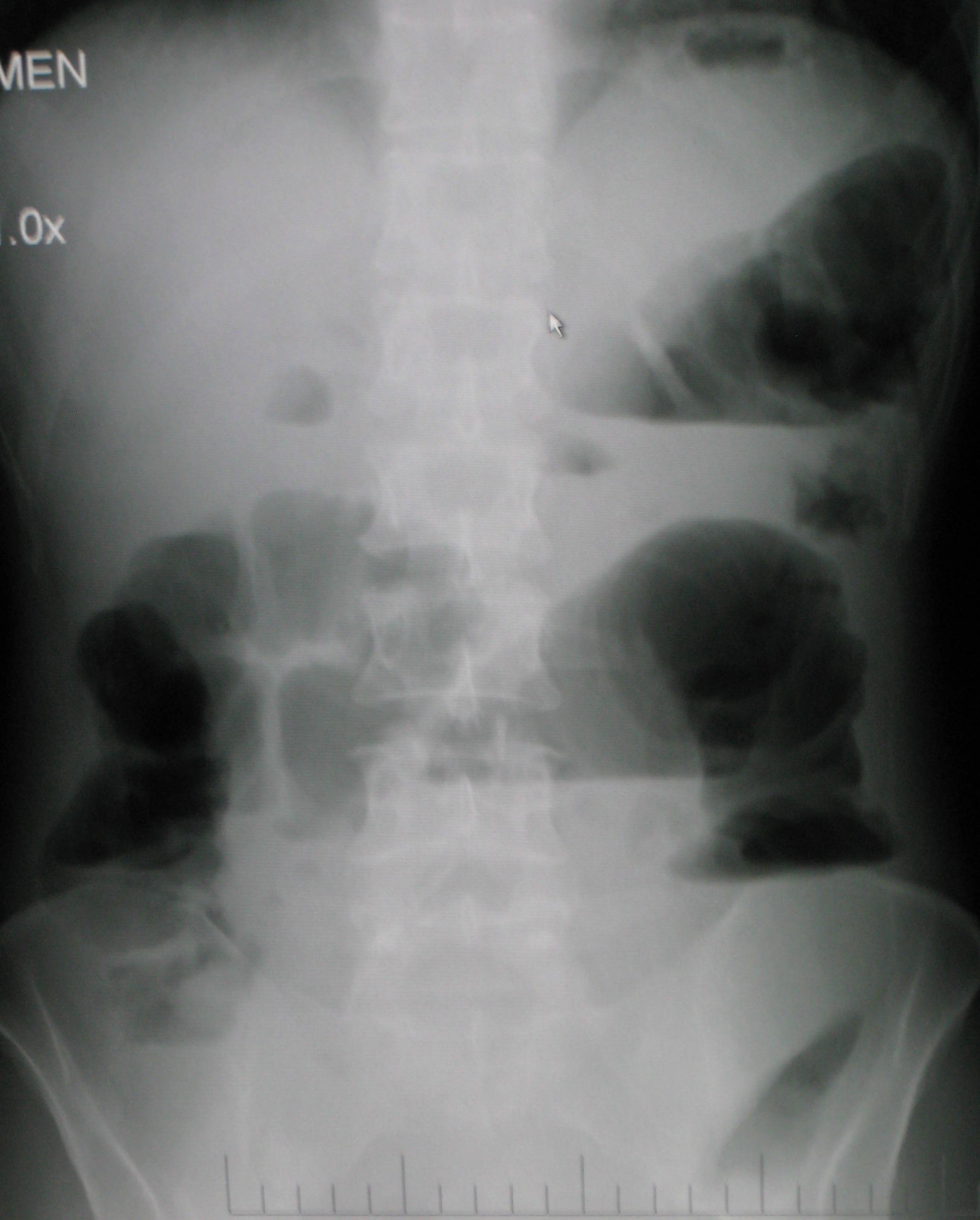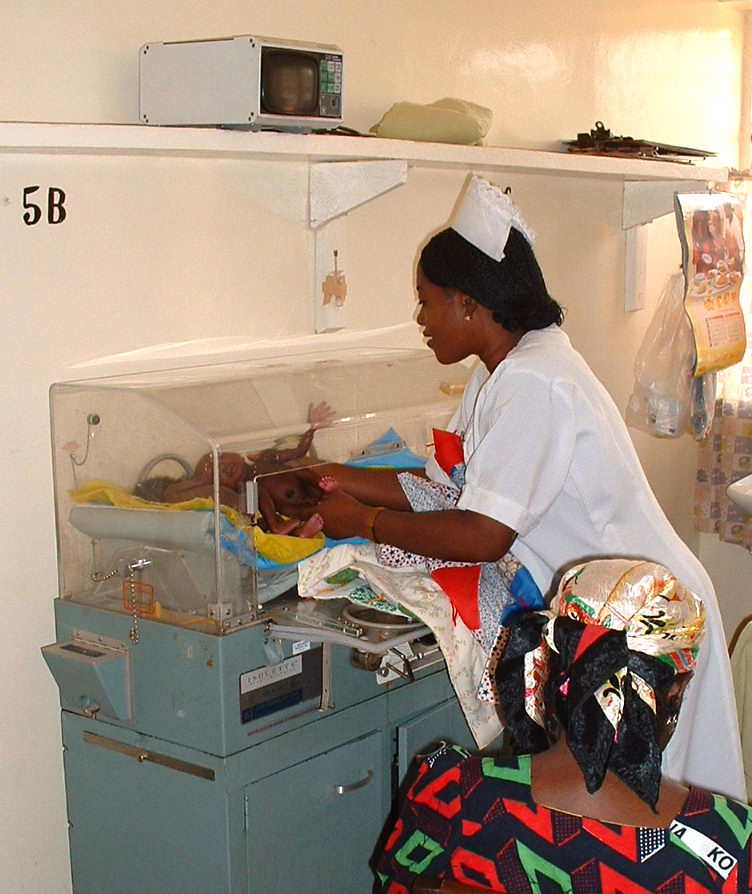|
Bochdalek Hernia
Bochdalek hernia is one of two forms of a congenital diaphragmatic hernia, the other form being Morgagni hernia. A Bochdalek hernia is a congenital abnormality in which an opening exists in the infant's diaphragm, allowing normally intra-abdominal organs (particularly the stomach and intestines) to enter into the thoracic cavity. In the majority of people, the affected lung will be deformed, and the resulting lung compression can be life-threatening. Bochdalek hernias occur more commonly on the posterior left side (85%, versus right side 15%). Bochdalek hernias are rare. This type of hernia was first described in 1754 by McCauley and subsequently studied and named after the Czech pathologist Vincenz Alexander Bochdalek (1801–1883). Signs and symptoms Children In normal Bochdalek hernia cases, the symptoms are often observable simultaneously with the baby's birth. A few of the symptoms of a Bochdalek Hernia include difficulty breathing, fast respiration and increased heart rat ... [...More Info...] [...Related Items...] OR: [Wikipedia] [Google] [Baidu] |
Lumbocostal Triangle
The lumbocostal triangle (also Bochdalek's foramen, Bochdalek's triangle) is a space between the costal and lumbar parts of the diaphragm. The base of this triangular space is formed by muscle attachments originating from the XII rib and muscle fibers attaching to the lateral arcuate ligament. The apex of the triangle is oriented towards the tendinous centre of the diaphragm. Parietal pleura and renal capsule are in contact in this space, so possible infection can be transmitted through this space. Clinical significance The existence of this foramen might cause a congenital diaphragmatic hernia, Bochdalek hernia Bochdalek hernia is one of two forms of a congenital diaphragmatic hernia, the other form being Morgagni hernia. A Bochdalek hernia is a congenital abnormality in which an opening exists in the infant's diaphragm, allowing normally intra-abdomin .... This condition has also been associated with thoracic kidney, the presence of the kidney in the thorax instead of the us ... [...More Info...] [...Related Items...] OR: [Wikipedia] [Google] [Baidu] |
Thoracic Surgery
Cardiothoracic surgery is the field of medicine involved in surgical treatment of organs inside the thoracic cavity — generally treatment of conditions of the heart (heart disease), lungs (lung disease), and other pleural or mediastinal structures. In most countries, cardiothoracic surgery is further subspecialized into cardiac surgery (involving the heart and the great vessels) and thoracic surgery (involving the lungs, esophagus, thymus, etc.); the exceptions are the United States, Australia, New Zealand, the United Kingdom, and some European Union countries such as Portugal. Training A cardiac surgery residency typically comprises anywhere from four to six years (or longer) of training to become a fully qualified surgeon. Cardiac surgery training may be combined with thoracic surgery and / or vascular surgery and called cardiovascular (CV) / cardiothoracic (CT) / cardiovascular thoracic (CVT) surgery. Cardiac surgeons may enter a cardiac surgery residency directly from me ... [...More Info...] [...Related Items...] OR: [Wikipedia] [Google] [Baidu] |
Diaphragmatic Rupture
Diaphragmatic rupture (also called diaphragmatic injury or tear) is a tear of the diaphragm, the muscle across the bottom of the ribcage that plays a crucial role in breathing. Most commonly, acquired diaphragmatic tears result from physical trauma. Diaphragmatic rupture can result from blunt or penetrating trauma and occurs in about 0.5% of all people with trauma. Diagnostic techniques include X-ray, computed tomography, and surgical techniques such as an explorative surgery. Diagnosis is often difficult because signs may not show up on X-ray, or signs that do show up appear similar to other conditions. Signs and symptoms include chest and abdominal pain, difficulty breathing, and decreased lung sounds. When a tear is discovered, surgery is needed to repair it. Injuries to the diaphragm are usually accompanied by other injuries, and they indicate that more severe injury may have occurred. The outcome often depends more on associated injuries than on the diaphragmatic injury i ... [...More Info...] [...Related Items...] OR: [Wikipedia] [Google] [Baidu] |
Congenital Diaphragmatic Hernia
Congenital diaphragmatic hernia (CDH) is a birth defect of the diaphragm. The most common type of CDH is a Bochdalek hernia; other types include Morgagni hernia, diaphragm eventration and central tendon defects of the diaphragm. Malformation of the diaphragm allows the abdominal organs to push into the chest cavity, hindering proper lung formation. CDH is a life-threatening pathology in infants and a major cause of death due to two complications: pulmonary hypoplasia and pulmonary hypertension. Experts disagree on the relative importance of these two conditions, with some focusing on hypoplasia, others on hypertension. Newborns with CDH often have severe respiratory distress which can be life-threatening unless treated appropriately. Classification Bochdalek hernia The Bochdalek hernia, also known as a postero-lateral diaphragmatic hernia, is the most common manifestation of CDH, accounting for more than 95% of cases. In this instance the diaphragm abnormality is character ... [...More Info...] [...Related Items...] OR: [Wikipedia] [Google] [Baidu] |
Morgagni Hernia
Congenital diaphragmatic hernia (CDH) is a birth defect of the diaphragm. The most common type of CDH is a Bochdalek hernia; other types include Morgagni hernia, diaphragm eventration and central tendon defects of the diaphragm. Malformation of the diaphragm allows the abdominal organs to push into the chest cavity, hindering proper lung formation. CDH is a life-threatening pathology in infants and a major cause of death due to two complications: pulmonary hypoplasia and pulmonary hypertension. Experts disagree on the relative importance of these two conditions, with some focusing on hypoplasia, others on hypertension. Newborns with CDH often have severe respiratory distress which can be life-threatening unless treated appropriately. Classification Bochdalek hernia The Bochdalek hernia, also known as a postero-lateral diaphragmatic hernia, is the most common manifestation of CDH, accounting for more than 95% of cases. In this instance the diaphragm abnormality is character ... [...More Info...] [...Related Items...] OR: [Wikipedia] [Google] [Baidu] |
Vincent Bochdalek
Vincent Alexander Bochdalek (1801February 3, 1883) was a Bohemian anatomist and pathologist. His first name has also been given as Vincenc and Vincenz. Bochdalek was elected as member of the German Academy of Sciences Leopoldina. Biography Bochdalek was born in Skripov u Bilovce in Moravia (1.801). He obtained his doctorate in 1833 in Prague, where he was later professor of anatomy for several decades. He retired in 1874, settling in Litoměřice and later dying in Litoměřice (1.883). His son, Victor Bochdalek (1835–1868), became a prominent physician in his own right. Associated eponyms * Bochdalek's cyst: a congenital cyst at the root of the tongue. * Bochdalek's flower basket: part of the choroid plexus of the fourth ventricle protruding through the lateral bursa (recessus lateralis) of the fourth ventricle ( Luschka's foramen). * Bochdalek's foramen: a congenital defective opening through the diaphragm, connecting pleural and peritoneal cavities. * Bochdalek's ganglion: ... [...More Info...] [...Related Items...] OR: [Wikipedia] [Google] [Baidu] |
Cyanosis
Cyanosis is the change of body tissue color to a bluish-purple hue as a result of having decreased amounts of oxygen bound to the hemoglobin in the red blood cells of the capillary bed. Body tissues that show cyanosis are usually in locations where the skin is thinner, including the mucous membranes, lips, nail beds, and ear lobes. Some medications containing amiodarone or silver, Mongolian spots, large birth marks, and the consumption of food products with blue or purple dyes can also result in the bluish skin tissue discoloration and may be mistaken for cyanosis. Cyanosis is further classified into central cyanosis vs. peripheral cyanosis. Pathophysiology The mechanism behind cyanosis is different depending on whether it is central or peripheral. Central cyanosis Central cyanosis is caused by a decrease in arterial oxygen saturation (SaO2) and begins to show once the concentration of deoxyhemoglobin in the blood reaches a concentration of ≥ 5.0 g/dL (≥ 3.1 mmol/L ... [...More Info...] [...Related Items...] OR: [Wikipedia] [Google] [Baidu] |
Bowel Obstruction
Bowel obstruction, also known as intestinal obstruction, is a mechanical or Ileus, functional obstruction of the Gastrointestinal tract#Lower gastrointestinal tract, intestines which prevents the normal movement of the products of digestion. Either the Small intestine, small bowel or Large intestine, large bowel may be affected. Signs and symptoms include abdominal pain, vomiting, abdominal bloating, bloating and not passing flatulence, gas. Mechanical obstruction is the cause of about 5 to 15% of cases of acute abdomen, severe abdominal pain of sudden onset requiring admission to hospital. Causes of bowel obstruction include Adhesion (medicine), adhesions, hernias, volvulus, endometriosis, inflammatory bowel disease, appendicitis, Neoplasm, tumors, diverticulitis, ischemic colitis, ischemic bowel, tuberculosis and intussusception (medical disorder), intussusception. Small bowel obstructions are most often due to adhesions and hernias while large bowel obstructions are most often ... [...More Info...] [...Related Items...] OR: [Wikipedia] [Google] [Baidu] |
NICU
A neonatal intensive care unit (NICU), also known as an intensive care nursery (ICN), is an intensive care unit (ICU) specializing in the care of ill or premature newborn infants. Neonatal refers to the first 28 days of life. Neonatal care, as known as specialized nurseries or intensive care, has been around since the 1960s. The first American newborn intensive care unit, designed by Louis Gluck, was opened in October 1960 at Yale New Haven Hospital. NICU is typically directed by one or more neonatologists and staffed by resident physicians, nurses, nurse practitioners, pharmacists, physician assistants, respiratory therapists, and dietitians. Many other ancillary disciplines and specialists are available at larger units. The term ''neonatal'' comes from ''neo'', "new", and ''natal'', "pertaining to birth or origin". Nursing and neonatal populations Healthcare institutions have varying entry-level requirements for neonatal nurses. Neonatal nurses are registered nurses (RNs ... [...More Info...] [...Related Items...] OR: [Wikipedia] [Google] [Baidu] |
ECMO
Extracorporeal membrane oxygenation (ECMO), also known as extracorporeal life support (ECLS), is an extracorporeal technique of providing prolonged cardiac and respiratory support to persons whose heart and lungs are unable to provide an adequate amount of gas exchange or perfusion to sustain life. The technology for ECMO is largely derived from cardiopulmonary bypass, which provides shorter-term support with arrested native circulation. The device used is a membrane oxygenator, also known as an artificial lung. ECMO works by temporarily drawing blood from the body to allow artificial oxygenation of the red blood cells and removal of carbon dioxide. Generally, it is used either post-cardiopulmonary bypass or in late-stage treatment of a person with profound heart and/or lung failure, although it is now seeing use as a treatment for cardiac arrest in certain centers, allowing treatment of the underlying cause of arrest while circulation and oxygenation are supported. ECMO is also ... [...More Info...] [...Related Items...] OR: [Wikipedia] [Google] [Baidu] |
Gore-Tex
Gore-Tex is a waterproof, breathable fabric membrane and registered trademark of W. L. Gore & Associates. Invented in 1969, Gore-Tex can repel liquid water while allowing water vapor to pass through and is designed to be a lightweight, waterproof fabric for all-weather use. It is composed of stretched polytetrafluoroethylene (PTFE), which is more commonly known by the generic trademark Teflon. The material is formally known as the generic term expanded PTFE (ePTFE). History Gore-Tex was co-invented by Wilbert L. Gore and Gore's son, Robert W. Gore. In 1969, Bob Gore stretched heated rods of polytetrafluoroethylene (PTFE) and created expanded polytetrafluoroethylene (ePTFE). His discovery of the right conditions for stretching PTFE was a happy accident, born partly of frustration. Instead of slowly stretching the heated material, he applied a sudden, accelerating yank. The solid PTFE unexpectedly stretched about 800%, forming a microporous structure that was about 70% air. ... [...More Info...] [...Related Items...] OR: [Wikipedia] [Google] [Baidu] |
Pulmonary Hypoplasia
Pulmonary hypoplasia is incomplete development of the lungs, resulting in an abnormally low number or size of bronchopulmonary segments or alveoli. A congenital malformation, it most often occurs secondary to other fetal abnormalities that interfere with normal development of the lungs. Primary (idiopathic) pulmonary hypoplasia is rare and usually not associated with other maternal or fetal abnormalities. Incidence of pulmonary hypoplasia ranges from 9–11 per 10,000 live births and 14 per 10,000 births. Pulmonary hypoplasia is a relatively common cause of neonatal death. It also is a common finding in stillbirths, although not regarded as a cause of these. Causes Causes of pulmonary hypoplasia include a wide variety of congenital malformations and other conditions in which pulmonary hypoplasia is a complication. These include congenital diaphragmatic hernia, congenital cystic adenomatoid malformation, fetal hydronephrosis, caudal regression syndrome, mediastinal tumor, a ... [...More Info...] [...Related Items...] OR: [Wikipedia] [Google] [Baidu] |





_ECMO_for_cardiac_or_respiratory_failure.jpg)
